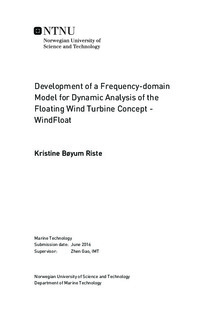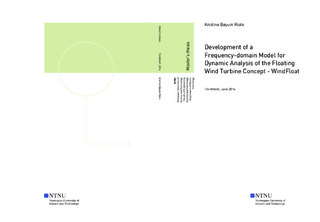| dc.description.abstract | In this master thesis a frequency domain method for dynamic response analysis of the floating wind turbine, WindFloat, has been established. The topic of response analysis in frequency domain is important for reducing computational time in preliminary design and fatigue calculations. The alternative approach with time-domain numerical methods are far more time consuming.
The main concern when establishing a frequency domain method, is that it requires a fully linear relationship between the load and response. Non-linear contributions in the dynamic equation of motion must therefore be linearised in a proper manner to reproduce the true response as correct as possible. The objective is to establish a frequency domain method for the WindFloat concept, and perform comparison to time-domain numerical methods.
The hydrodynamic model has been obtained by Wadam-analysis in HydroD, while the aerodynamic model was acquired by a state-space model.
Comparison of the results from the time-domain numerical method and the frequency domain method has been performed for three load-cases.
The wind induced motions and wave induced motions have been examined separately. The results indicate that the non-linear contributions are of significance for both wind and wave-induced motions.
For the wind induced motions the comparison has only been applied for one simulation in SRA, while for the wave induced motions, averaging over ten simulations has been performed. Thus, the frequency domain method for wind induced motions is not properly validated and further investigation is recommended. The results indicate that the excitation in the low frequency domain is of significance, but that they are poorly represented in the range where the transfer functions have been extrapolated, for frequencies close to zero.
For the hydrodynamic model, the prediction of standard deviations and peak frequencies in the wave frequency range had less than 2.5\% error for all of the loading conditions, with exception of the extreme environmental condition. In the low frequency domain, the results had varying success, due to poor representation of the transfer function close to zero.
For further application of the hydrodynamic model it advised to either disregard the extrapolated solution, or more adequate, to implement values that can be interpolated. The wind-induced motions are highly dependent on the representation of the transfer functions to be correct. To get a better representation of the true behaviour, more work has to be performed on the aerodynamic model, both regarding validation, and correcting the transfer-functions. | |

